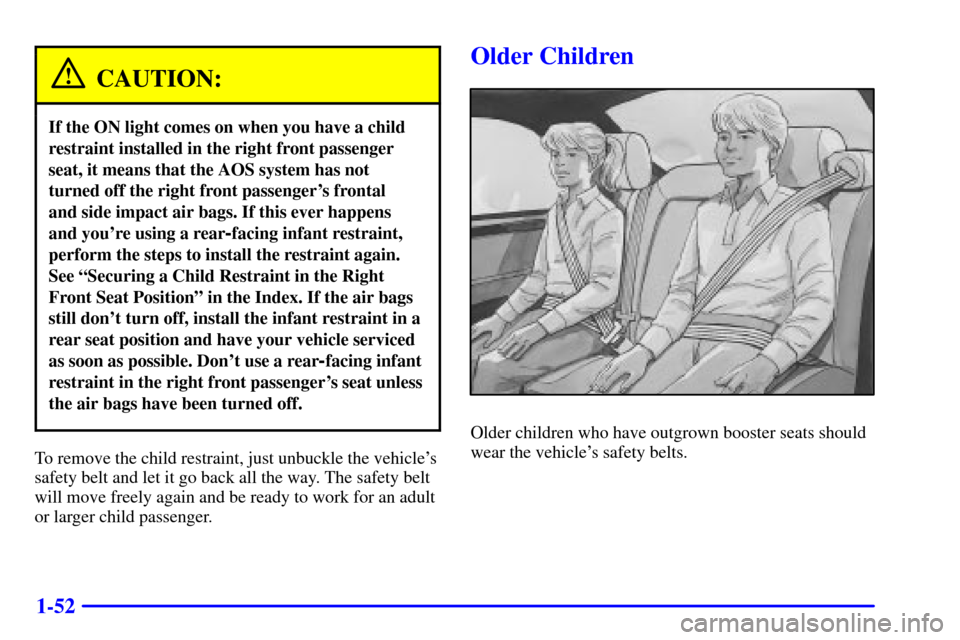Page 54 of 371
1-42
A forward-facing child seat (C-E) provides restraint for
the child's body with the harness and also sometimes
with surfaces such as T
-shaped or shelf-like shields.
A booster seat (F-G) is a child restraint designed to
improve the fit of the vehicle's safety belt system.
Some booster seats have a shoulder belt positioner,
and some high
-back booster seats have a five-point
harness. A booster seat can also help a child to see out
the window.
Page 55 of 371

1-43
Q:How do child restraints work?
A:A child restraint system is any device designed for
use in a motor vehicle to restrain, seat, or position
children. A built
-in child restraint system is a
permanent part of the motor vehicle. An add
-on
child restraint system is a portable one, which is
purchased by the vehicle's owner.
For many years, add
-on child restraints have
used the adult belt system in the vehicle. To help
reduce the chance of injury, the child also has to
be secured within the restraint. The vehicle's belt
system secures the add
-on child restraint in the
vehicle, and the add
-on child restraint's harness
system holds the child in place within the restraint.
One system, the three
-point harness, has straps
that come down over each of the infant's shoulders
and buckle together at the crotch. The five
-point
harness system has two shoulder straps, two hip
straps and a crotch strap. A shield may take the
place of hip straps. A T
-shaped shield has shoulder
straps that are attached to a flat pad which rests low
against the child's body. A shelf
- or armrest-type
shield has straps that are attached to a wide,
shelf
-like shield that swings up or to the side.When choosing a child restraint, be sure the child
restraint is designed to be used in a vehicle. If it is,
it will have a label saying that it meets federal motor
vehicle safety standards.
Then follow the instructions for the restraint. You may
find these instructions on the restraint itself or in a
booklet, or both. These restraints use the belt system in
your vehicle, but the child also has to be secured within
the restraint to help reduce the chance of personal injury.
When securing an add
-on child restraint, refer to the
instructions that come with the restraint which may be
on the restraint itself or in a booklet, or both, and to this
manual. The child restraint instructions are important,
so if they are not available, obtain a replacement copy
from the manufacturer.
Page 59 of 371
1-47 Securing a Child Restraint in a Rear
Seat Position
You'll be using the lap-shoulder belt. See the earlier
part about the top strap if the child restraint has one.
Be sure to follow the instructions that came with the
child restraint. Secure the child in the child restraint
when and as the instructions say.
1. Put the restraint on the seat.
2. Pick up the latch plate, and run the lap and shoulder
portions of the vehicle's safety belt through or
around the restraint. The child restraint instructions
will show you how.
Tilt the latch plate to adjust the belt if needed.
If the shoulder belt goes in front of the child's face
or neck, put it behind the child restraint.
Page 60 of 371
1-48
3. Buckle the belt. Make sure the release button is
positioned so you would be able to unbuckle the
safety belt quickly if you ever had to.4. To tighten the belt, pull up on the shoulder belt while
you push down on the child restraint. If you're using
a forward
-facing child restraint, you may find it
helpful to use your knee to push down on the child
restraint as you tighten the belt.
5. Push and pull the child restraint in different
directions to be sure it is secure.
To remove the child restraint, just unbuckle the vehicle's
safety belt and let it go back all the way. The safety belt
will move freely again and be ready to work for an adult
or larger child passenger.
Page 61 of 371

1-49 Securing a Child Restraint in the Right
Front Seat Position
Your vehicle has a right front passenger air bag. Unless
your vehicle has the Automatic Occupant Sensor (AOS)
system, never put a rear
-facing child restraint in this
seat. Here's why:
CAUTION:
A child in a rear-facing child restraint can be
seriously injured or killed if the right front
passenger's air bag inflates. This is because the
back of the rear
-facing child restraint would be
very close to the inflating air bag. Always secure
a rear
-facing child restraint in the rear seat.
Although a rear seat is a safer place, you can secure a
forward
-facing child restraint in the right front seat.
You'll be using the lap
-shoulder belt. See the earlier
part about the top strap if the child restraint has one.
Be sure to follow the instructions that came with the
child restraint. Secure the child in the child restraint
when and as the instructions say.
1. Your vehicle has a right front passenger's air bag.
If your vehicle has the Automatic Occupant Sensor
(AOS) system and you're using a rear
-facing child
restraint in this seat, make sure the air bag is turned
off by looking at the status indicator in the rearview
mirror before you drive. See ªAutomatic Occupant
Sensor (AOS) Systemº in the Index for more on
this, including important safety information. If your
vehicle doesn't have the AOS system and you're
using a forward
-facing child restraint, always move
the seat as far back as it will go before securing it in
this seat. See ªSeatsº in the Index.
2. Put the restraint on the seat.
Page 62 of 371
1-50
3. Pick up the latch plate, and run the lap and shoulder
portions of the vehicle's safety belt through or
around the restraint. The child restraint instructions
will show you how.
If the shoulder belt goes in front of the child's face or
neck, put it behind the child restraint.
4. Buckle the belt. Make sure the release button is
positioned so you would be able to unbuckle the
safety belt quickly if you ever had to.
5. Pull the rest of the lap belt all the way out of the
retractor to set the lock.
Page 63 of 371
1-51
6. To tighten the belt, feed the lap belt back into the
retractor while you push down on the child restraint.
You may find it helpful to use your knee to push
down on the child restraint as you tighten the belt.7. Push and pull the child restraint in different
directions to be sure it is secure.
8. If your vehicle has the Automatic Occupant Sensor
(AOS) system, before you begin to drive, check to
be sure the right front passenger's frontal and side
impact air bags are off if you're using a rear
-facing
infant restraint. If the air bags are off, the word OFF
will appear in the rearview mirror.
If the word ON appears in the rearview mirror, the
frontal and side impact air bags have not been turned
off. If this ever happens, unbuckle the safety belt and
perform the steps to install the rear
-facing restraint
again. If the air bags still don't turn off, install the
infant restraint in a rear seat position and have your
vehicle serviced as soon as possible.
Page 64 of 371

1-52
CAUTION:
If the ON light comes on when you have a child
restraint installed in the right front passenger
seat, it means that the AOS system has not
turned off the right front passenger's frontal
and side impact air bags. If this ever happens
and you're using a rear
-facing infant restraint,
perform the steps to install the restraint again.
See ªSecuring a Child Restraint in the Right
Front Seat Positionº in the Index. If the air bags
still don't turn off, install the infant restraint in a
rear seat position and have your vehicle serviced
as soon as possible. Don't use a rear
-facing infant
restraint in the right front passenger's seat unless
the air bags have been turned off.
To remove the child restraint, just unbuckle the vehicle's
safety belt and let it go back all the way. The safety belt
will move freely again and be ready to work for an adult
or larger child passenger.
Older Children
Older children who have outgrown booster seats should
wear the vehicle's safety belts.